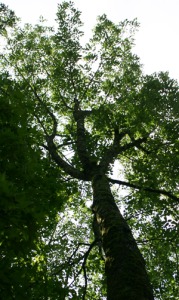Last summer the Arkansas Agriculture Department and USDA’s Animal and Plant Health Inspection Service (APHIS) announced that emerald ash borer (EAB) had been discovered in five counties in southwest Arkansas, bringing this pest only one county away from Texas. Despite the fact that it feeds only on ash (trees in the genus Fraxinus), the EAB is considered to be the most destructive forest pest ever seen in north America.
Because it is getting so close to Texas, I thought I would speculate a little about what impact EAB might have on our state.
The good news is that almost certainly the economic impact of this pest in Texas will be less than its impact in other states like Michigan and Ohio. That’s because ash is less frequently planted here, and it makes up less of the native forest canopy compared to the Midwest. In east Texas, where most ash is located, less than 2% of the forest canopy consists of ash. Fewer trees generally means less economic damage, and lower visual impact to city streets.
According to Missouri Forest Entomologist, Rob Lawrence, that state’s average ash percentage on urban streets is 14% with a few parks reaching 30-40%; but in its native forest ash constitutes only 3% of trees. According to entomologist Eric Rebek in Oklahoma, in his state’s two biggest cities, Oklahoma City and Tulsa, ash trees make up 10% of planted trees; but only 2% of the hardwood harvest in natural forests.
Compare these numbers with ash numbers in Iowa (average of 16.5% of urban trees, some communities up to 87% ash), Pennsylvania (14% of all trees). Even Colorado reports ash composition of city trees at between 15 and 25% of all shade trees. In the Chicago area, where EAB has hit hard, 12% of city trees are estimated to be ash, and about 15% in Minneapolis.
The other thing in Texas’ favor is that there has now been over ten years of research on control of EAB; and some effective treatments are available for at-risk trees. The most effective treatments are systemic insecticides which can be applied to the base of the trunk, or injected, or sprayed on the bark. These insecticides include emamectin benzoate, imidacloprid, and dinotefuran. There is even a naturally-derived treatment, azadirachtin, that can protect trees for up to a year.
David Smitley, Michigan State University entomologist, reports that in 2010, the city of Midland injected all ash trees felt to be worth protecting (about 50% of the ash in the city) with emamectin benzoate. Results exceeded expectations when all treated (and most untreated!) trees survived. This contrasted with four other surrounding communities that treated lower percentages of their trees. Although treated trees were well protected, nearly all the untreated (control) ash trees in these other communities died within four years. Smitley attributes the high survival rate of the untreated control trees in Midland to beetle populations crashing from exposure to the high number of treated trees (adult beetles feeding on leaves of a treated tree will die). Once a city stops an EAB outbreak with mass tree treatment, and enters a maintenance phase, experience shows that ash trees should not need to be treated more than once every 2-3 years.
The point of all this is that there are good management strategies for communities who decide to protect their street trees. Texas Forest Service urban forester, Courtney Blevins, doubts whether most Texas cities will opt to treat because ashes are not widely planted as shade trees here. Most of the ash in the Dallas area is Arizona ash, was planted 30-40 years ago, and is no longer in favor as a city tree. The greater impact will likely occur in the native Texas forest, where stately ash trees add to the diversity and beauty of the east Texas woods.
This may be of little consolation to you if you have a valued ash tree in your yard. If this is the case, there are good treatments (mentioned above), should you decide to protect your tree. By the way, there is no need to worry about treating your tree(s) until emerald ash borer is confirmed withing 10-15 miles of your home.
We will continue to monitor for emerald ash borer throughout east Texas in 2015 as part of an APHIS-funded survey. For more information about emerald ash borer from a multistate collaboration, see http://www.emeraldashborer.info.
